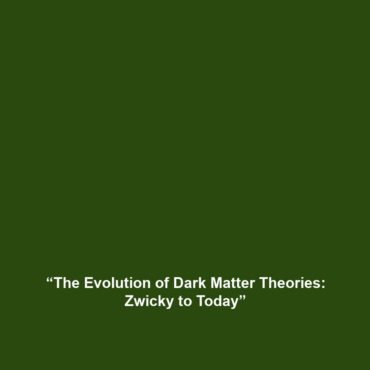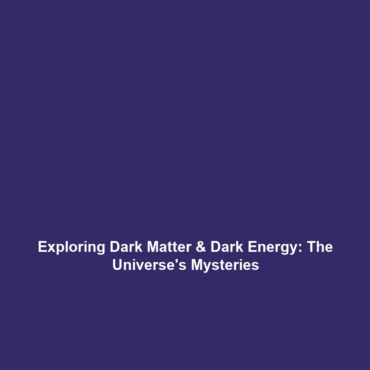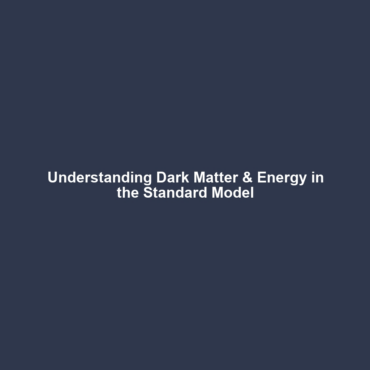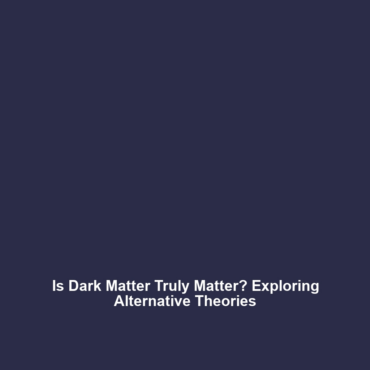The History of Dark Matter Theories: From Zwicky to Today
Introduction: The study of dark matter and dark energy remains one of the most captivating and challenging areas of modern astrophysics. Beginning with Fritz Zwicky’s pioneering work in the early 20th century, theories explaining dark matter have evolved significantly. This article traces the intellectual journey from Zwicky’s initial observations of galaxy clusters, which hinted at unseen mass, to contemporary frameworks that attempt to unravel the enigmatic nature of dark matter and dark energy. Understanding these theories is crucial not only for astrophysics but also for our comprehension of the universe’s structure and evolution.
Key Concepts in Dark Matter Theories
The evolution of dark matter theories has seen various key concepts emerge that are essential to understanding dark matter and dark energy:
- Zwicky’s Notion of Missing Mass: In the 1930s, Zwicky observed that the visible mass of galaxies in the Coma cluster was insufficient to account for their gravitational binding, leading him to propose the existence of dark matter.
- Galaxy Rotation Curves: In the 1970s, the work of astronomers such as Vera Rubin and Kent Ford provided evidence that galaxies rotate at speeds that could not be explained by visible matter alone, further supporting the dark matter hypothesis.
- WIMPs and Axions: Theoretical particles such as Weakly Interacting Massive Particles (WIMPs) and axions have been proposed as potential dark matter candidates, contributing to the current research landscape.
- Large-scale Structure Formation: Theories of dark matter are essential in cosmology to explain the formation of large-scale structures within the universe and the cosmic microwave background radiation.
Applications of Dark Matter Theories
Real-World Uses: The history of dark matter theories has significant applications in various areas:
- Astronomical Observations: Modern telescopes leverage dark matter theories to better interpret galactic formation and cosmic events.
- Cosmological Simulations: Advanced simulations, based on these theories, help researchers predict the universe’s evolution, guiding observational efforts.
- Astrophysical Models: Dark matter theories are foundational in developing models that explain the behavior of stars and galaxies.
Current Challenges in Dark Matter Research
Challenges of Dark Matter Theories: Despite advancements, several challenges remain:
- Detection Issues: Many proposed dark matter particles have yet to be detected, complicating validation of existing theories.
- Theoretical Uncertainties: Discrepancies between theoretical predictions and observational data continue to pose significant hurdles.
- Complexity of Dark Energy: The relationship between dark energy and dark matter is not yet fully understood, leading to potential misinterpretations of cosmic phenomena.
Future Research and Innovations
Innovations in Dark Matter Studies: Looking forward, several innovations and research directions are poised to impact our understanding of dark matter:
- Next-Generation Detectors: Recent advancements in detector technology aim to enhance the sensitivity required for direct dark matter detection.
- Updated Cosmological Models: Ongoing collaborations in the scientific community are expected to refine models explaining dark matter interactions with ordinary matter.
- Astrophysical Observations: Upcoming space missions will significantly improve our ability to study dark matter’s influence on cosmic structures.
Conclusion
The history of dark matter theories, beginning with the groundbreaking insights of Fritz Zwicky to the present state of research, illustrates a complex evolution of ideas that are crucial to our understanding of the universe. As challenges remain, future research and technological innovations hold promise to illuminate the mysteries of dark matter and dark energy further. For more insights on dark matter theories, explore our other articles on Dark Matter Cosmology and Dark Energy Research.





